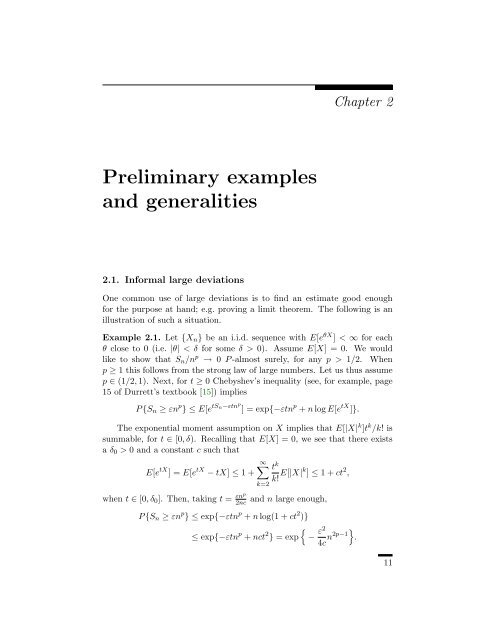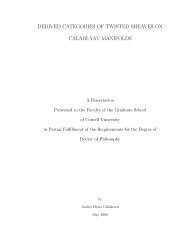A Course on Large Deviations with an Introduction to Gibbs Measures.
A Course on Large Deviations with an Introduction to Gibbs Measures.
A Course on Large Deviations with an Introduction to Gibbs Measures.
Create successful ePaper yourself
Turn your PDF publications into a flip-book with our unique Google optimized e-Paper software.
Preliminary examples<br />
<strong>an</strong>d generalities<br />
2.1. Informal large deviati<strong>on</strong>s<br />
Chapter 2<br />
One comm<strong>on</strong> use of large deviati<strong>on</strong>s is <strong>to</strong> find <strong>an</strong> estimate good enough<br />
for the purpose at h<strong>an</strong>d; e.g. proving a limit theorem. The following is <strong>an</strong><br />
illustrati<strong>on</strong> of such a situati<strong>on</strong>.<br />
Example 2.1. Let {Xn} be <strong>an</strong> i.i.d. sequence <strong>with</strong> E[e θX ] < ∞ for each<br />
θ close <strong>to</strong> 0 (i.e. |θ| < δ for some δ > 0). Assume E[X] = 0. We would<br />
like <strong>to</strong> show that Sn/n p → 0 P -almost surely, for <strong>an</strong>y p > 1/2. When<br />
p ≥ 1 this follows from the str<strong>on</strong>g law of large numbers. Let us thus assume<br />
p ∈ (1/2, 1). Next, for t ≥ 0 Chebyshev’s inequality (see, for example, page<br />
15 of Durrett’s textbook [15]) implies<br />
P {Sn ≥ εn p } ≤ E[e tSn−εtnp<br />
] = exp{−εtn p + n log E[e tX ]}.<br />
The exp<strong>on</strong>ential moment assumpti<strong>on</strong> <strong>on</strong> X implies that E[|X| k ]t k /k! is<br />
summable, for t ∈ [0, δ). Recalling that E[X] = 0, we see that there exists<br />
a δ0 > 0 <strong>an</strong>d a c<strong>on</strong>st<strong>an</strong>t c such that<br />
E[e tX ] = E[e tX − tX] ≤ 1 +<br />
when t ∈ [0, δ0]. Then, taking t = εnp<br />
2nc<br />
∞<br />
k=2<br />
t k<br />
k! E[|X|k ] ≤ 1 + ct 2 ,<br />
<strong>an</strong>d n large enough,<br />
P {Sn ≥ εn p } ≤ exp{−εtn p + n log(1 + ct 2 )}<br />
≤ exp{−εtn p + nct 2 } = exp<br />
<br />
− ε2<br />
4c n2p−1<br />
.<br />
11
















